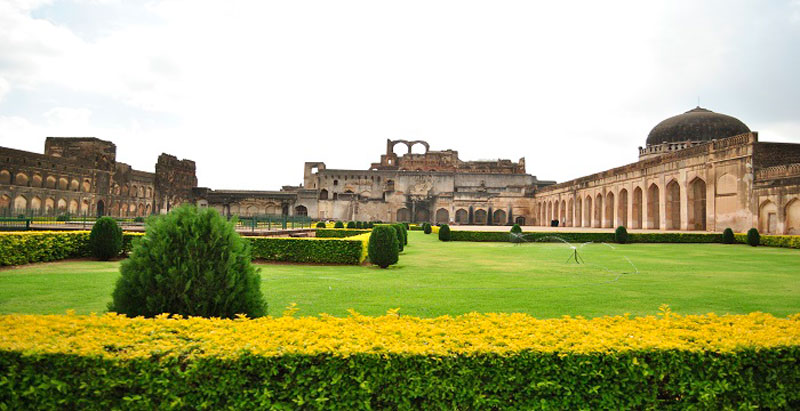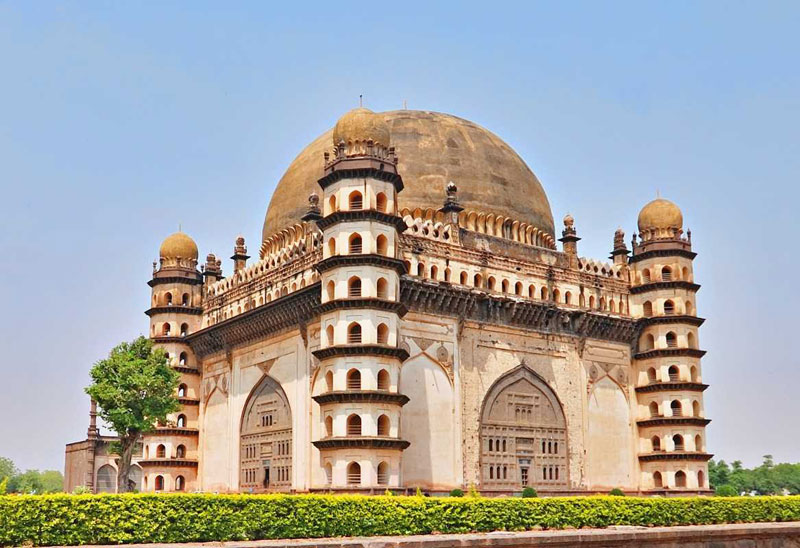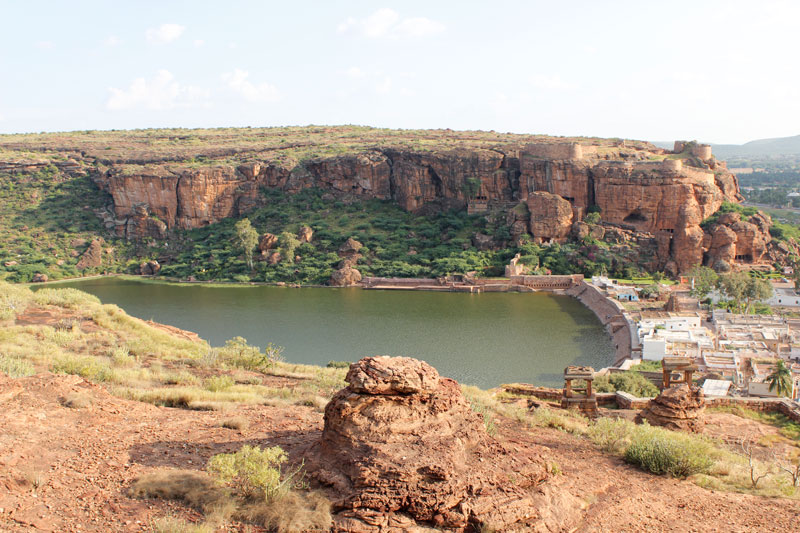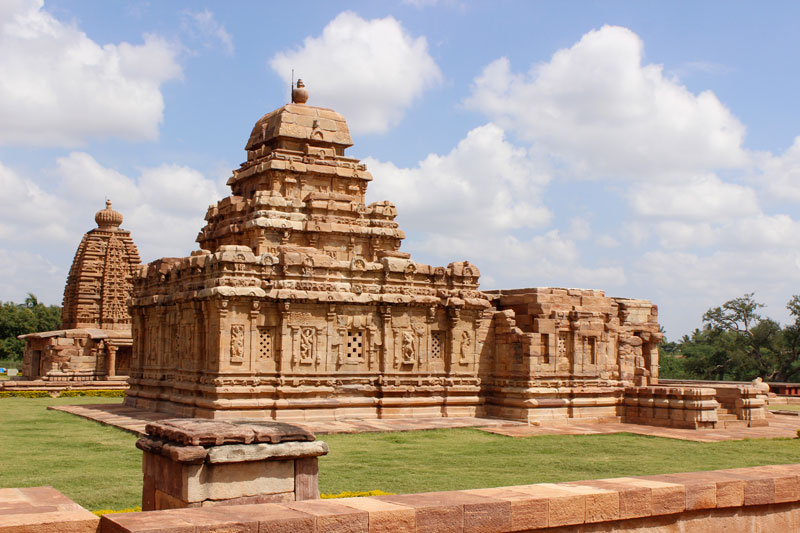Highlights of South India Architectural Tour
South India is the perfect place to observe some of the finest ancient Indian architecture. Apart from Hindu architecture, this trip covers a few landmark monuments of Islamic architecture as well. 06th century Cave temples of Badami are the brightest examples of rock-cut Indian architecture. Many architects from the world have described Aihole and Badami Caves as a cradle of temple architecture in India.
Chalukya dynasty built group of temples during 07th and 08th centuries at Pattadakal and UNESCO has classified them as world heritage sites. Hampi – the erstwhile capital of the prestigious Vijayanagara Empire was one of the largest and richest cities in the world. Another prominent Empire in Karnataka was Hoysala in the 12th Century and Halebidu was its regal capital.
The splendid workmanship of the Hoysala period is witnessed at the temple complex of Belur and Halebidu. And Karnataka's visit is never complete without visiting its crown - Mysore Palace. It is built in Indo-Saracenic architecture and one of the largest private residences in the world.
Itinerary Details
Day 01
Welcome at Hyderabad Airport
Hyderabad
Arrive at Hyderabad and transfer to the hotel. Hyderabad is also known as the city of pearls because it was a diamond and pearl trading center in the past.
Day 02
Hyderabad Sightseeing Tour
Hyderabad
Today our guide will take you on the Hyderabad sightseeing tour, Beginning with Charminar, the classic mark of the Hyderabad city. Situated in the center of the city the monument was built to honor the origin of Hyderabad.
Four minarets towering almost 50ft high poise the structure. Later visit Golconda Fort – one of the imposing forts of South India. The fort houses remain of armories, mosques, reservoirs, royal dwellings, and multiple defense layers and depict the grandeur of the Mughal Era.
Later in the evening, visit the attractions Qutub Shahi Tombs and Mecca Masjid. Situated amidst the Ibrahim Bagh, Qutub Shahi Tombs contains several tombs and mosques constructed by the various rulers of the Qutb Shahi Dynasty. It is only one of its kind in the world where in one place an entire dynasty has been buried.
Mecca Masjid was built in 1694 by Muhammad Quli Qutb Shah of the Qutub Shahi dynasty. The soil from which the bricks of the central arch were made, was brought from the Islamic holy site, Mecca. Consequently, the mosque got its name Mecca Masjid.
Day 03
Drive to Bidar (04 Hours)
Hyderabad-Bidar
After breakfast, drive to Bidar. On arrival check-in to the hotel and take some rest. Later take a guided tour of Bidar Fort. Built by Sultan Alla-Ud Din Bahman in the 14th century, the Bidar Fort complex houses more than 30 monuments.
Designed with Persian Style architecture this fort features excellent woodcarvings and captivating glassy tile mosaics. Also visit the Bahmani Ruler’s Tomb, which is a great example of the historical architecture of the Bahmani era. The interior of these square tombs has been wonderfully carved and colored.
Day 04
Drive to Gulbarga (03 Hours)
Bidar-Gulbarga
In the morning take a leave from Bidar to drive for Gulbarga. On arrival check-in to the hotel and later take a sightseeing tour of enormous Gulbarga Fort.
Gulbarga Fort is one of the initial examples of Islamic architecture in Karnataka. The main attractions of the fort complex are Tomb of Khaja Bande Nawaz, Jama Masjid and the main Fort.
Day 05
Drive to Bijaipur (03 Hours)
Gulbarga-Bijapur
Today, drive further to Bijapur. Visit Gol Gumbaz- the central dome of Gol Gumbaz is second to the dome of St Peter’s Basilica of Rome in size. This Gumbaz stands unsupported by any pillars. It serves as the crypt of King Mohammed Adil Shah (Sultan of Bijapur).
Also, take the tour of Ibrahim Roza – it is a palatial Mosque considered as one of the forerunners of Taj Mahal and measured as one of the supreme exemplars of Islamic architecture.
Day 06
Drive to Badami (03 Hours)
Bijapur-Badami
Arrive at Badami and visit the superb Badami Caves Complex, which includes four ancient rock-cut cave temples. The caves complex is one of the examples of Hindu Temples of the ancient Deccan period. Later visit Badami Fort and Bhutanatha temples. Badami Fort is a well-known archaeological location that is situated on the apex of a hill.
King Pulakeshi of Chalukya Dynasty constructed this ancient fortress. The Bhutanatha temples are a group of sandstone temples dedicated to the God Bhutanatha. The architecture of the temples is an amalgamation of different architecture of different periods.
Day 07
Badami-Aihole (01 Hour) Aihole-Pattadakal (30 Minutes) Pattadakal-Hampi (04 Hours)
Badami-Aihole-Pattadakal-Hampi
Proceed to Hampi stop en route to visit Pattadakal, a UNESCO world heritage site located on the banks of the Malaprabha River. It is a compound of the seventh and eighth-century’s Hindu and Jain temples. Pattadakal is evidence of the wealth and prosperity of Chalukyan architecture. Also stop on the way at Aihole, known as ‘the cradle of Indian Architecture’. It houses various ancient as well as the medieval era’s Hindu, Buddhist, and Jain monuments. Upon arrival at Hampi Hotel, complete the check-in and relax.
Day 08
Hampi Sightseeing Tour
Hampi
Take a full day trip to Hampi – a UNESCO world heritage site. Hampi was the splendid capital of the great Vijayanagara Empire. Hampi is currently a ruined city that holds over 1,600 existing remains of riverside features, forts, sacred and royal complexes, temples, pillared halls, water structures and more belonging to ancient Hindu Dynasty of South India.
Hampi is the perfect place to see the Hindu architecture.Day 09
Drive to Hassan (08 Hours)
Hampi-Hassan
In the morning leave for Hassan; en route take the tour of Halebid and Belur. During the 12th century, Halebid was the royal capital of the Empire of Hoysala. The city is acknowledged for its temple complexes such as Hoysaleshwara temple and Kedareshwara temple. Belur is well-known for its Chennakeshava Temple, one of the premium exemplars of Hoysala artistry that is still active.
Finally, reach to Hassan and take rest at the hotel.Day 10
Drive to Mysore (03 Hours)
Hassan-Mysore
Today, after breakfast drive to “city of Palaces”, Mysore; en-route visit Shravanabelagola- one of the prominent Jain pilgrim centers in India. It is believed Chandragupta Maurya (founder of Maurya Reign) had died in this town in 298 BC after he turned into a Jain monk and implicated an ascetic lifestyle.
On arrival at Mysore take a guided tour of Chamundi Hills to view a huge Nandi Bull built out of a single rock-hewn. You can also visit Chamundeshwari Temple situated on the top of the Chamundi hills. Later visit the Mysore Palace, which is one of the most magnificent palaces in Southern India. Mysore Palace is the bench of the Kingdom of Mysore and the official home of the Wadiyar dynasty.
Day 11
Drive to Bangalore (04 Hours) International Departure
Mysore-Bangalore-Departure
In the morning, post breakfast take an excursion to Somnathpura (a small village located on the banks of River Kaveri) to visit Chennakesava Temple. Chennakesava Temple is one of the best examples of Hoysala style architecture. The ceiling and walls of the temple are beautifully carved with the Hinduism’s Theological iconography and it also depicts friezes of various Hindu Epics.
Later depart Mysore for Bangalore by road. En-route, visit Srirangapatanam – the summer capital of Tipu Sultan that holds great cultural, religious and historic importance. On arrival at Bangalore, you will be transferred to Airport for onward journey.
Feedback from Guests Who Joined this Tour in Past

Emily, USA

Simone, South Africa

John Paul, South Africa
















